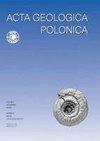Palynostratigraphy of dinosaur bone-bearing deposits from the Upper Cretaceous of Western Bulgaria
IF 0.9
4区 地球科学
Q3 GEOLOGY
引用次数: 1
Abstract
Palynological investigation of the Vrabchov dol locality (Western Bulgaria) which recently yielded fragmentary dinosaur bones attributed to the clade Titanosauria, reveals well-preserved sporomorph assemblages dominated by angiosperm pollen from the Normapolles group, spores and rare gymnosperms. The age assessment of the studied sequence is based on the diagnostic Normapolles species, such as Oculopollis orbicularis Goczan, 1964, Oculopollis zaklinskaiae Goczan, 1964, Krutzschipollis spatiosus Goczan in Goczan et al., 1967 and Krutzschipollis crassus (Goczan, 1964) Goczan in Goczan et al., 1967. The concurrent presence of these pollen species suggests a late Santonian–early Campanian age for the succession. The sporomorph association is encountered in a palynofacies dominated by continental elements, including translucent phytoclasts (tissues, wood remains and plant cuticles). The sedimentary succession shows no evidence of marine elements and a very low proportion of AOM that attests to deposition within a lagoonal to foreshore marine environment, with high continental input and short transportation. The vegetation in the studied area was primarily composed of a range of Normapolles-producing angiosperms and secondarily of pteridophyte spore-producing plants. Gymnosperms were rare. Such a vegetation pattern reflects a warm, seasonally dry climate during the late Santonian–earliest Campanian in the studied area. The dinosaurs inhabited a wet lowland area, probably rich in herbaceous plants.保加利亚西部上白垩纪恐龙骨沉积物的孢粉地层
对Vrabchov dol地区(保加利亚西部)的孢粉学调查显示,最近发现了属于泰坦龙进化支的恐龙骨骼碎片,揭示了保存完好的孢子形态组合,主要是来自Normapolles群的被子植物花粉,孢子和罕见的裸子植物。所研究序列的年龄评估是基于Normapolles的诊断种,如Oculopollis orbicularis Goczan, 1964, Oculopollis zaklinskaiae Goczan, 1964, Krutzschipollis spatiosus Goczan in Goczan et al., 1967和Krutzschipollis crassus (Goczan, 1964) Goczan in Goczan et al., 1967。这些花粉种类的同时存在表明,这一演替发生在圣东尼亚晚期-坎帕尼亚早期。孢子形态组合是在以大陆元素为主的孢粉相中遇到的,包括半透明的植物碎屑(组织、木材残骸和植物角质层)。沉积演替中没有海洋元素的证据,AOM的比例很低,证明沉积在泻湖到前滨海洋环境中,大陆输入大,运输短。研究区植被以产normapolols的被子植物为主,其次为产孢子的蕨类植物。裸子植物很罕见。这种植被格局反映了研究区圣东晚期-坎帕尼亚早期温暖、季节性干燥的气候。恐龙生活在潮湿的低地地区,那里可能有丰富的草本植物。
本文章由计算机程序翻译,如有差异,请以英文原文为准。
求助全文
约1分钟内获得全文
求助全文
来源期刊

Acta Geologica Polonica
地学-地质学
CiteScore
1.70
自引率
18.20%
发文量
0
审稿时长
>12 weeks
期刊介绍:
Acta Geologica Polonica publishes original and review papers on all aspects of basic geology, with particular focus on sedimentology, stratigraphy, palaeontology, regional geology, structural geology, and regional petrography. All papers are published in English.
 求助内容:
求助内容: 应助结果提醒方式:
应助结果提醒方式:


